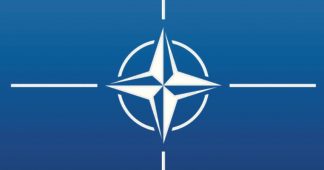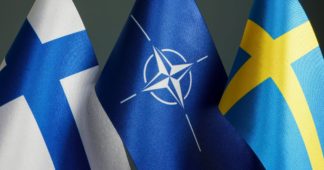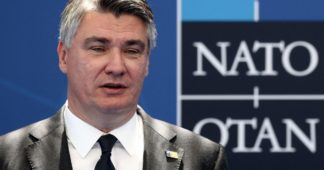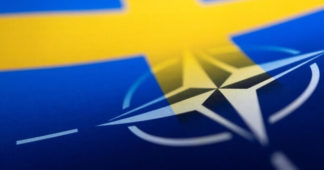By Herman Michiel
May 13, 2021
Looking back over the last 30 years, since the end of the Soviet Union (December 1991), one sees the steady expansion of the Western military alliance eastwards, up to the border with Russia. With the reunification of Germany, the ex-GDR became the first NATO victory, then followed by several waves of expansion: 1999: Poland, Hungary and the Czech Republic, 2004: the Baltic States, Bulgaria, Romania, Slovakia and Slovenia, 2009: Albania and Croatia, 2017: Montenegro, 2020: Republic of North Macedonia. An enormous success for Washington, which has made NATO the instrument for defending American geostrategic interests worldwide.
An outright disaster for world peace, however, because the American strategists have fiercely resisted all attempts, not only to end the Cold War, but to reduce the chances of war in general, in particular the chance of nuclear conflict. The American ‘njet’ to peace proposals was already evident in the 1980s under Soviet leader Gorbachev and then – after the dissolution of the Warsaw Pact – under the very Western-friendly Russian president Yeltsin, and even under his successor Putin. If the term ‘peace dividend’ [1] has barely penetrated the political vocabulary, it is because the United States, whether under Democrat or Republican administration, has actively campaigned for Western military and nuclear presence to have absolute priority over world peace. Those who find this a partisan interpretation should read the strictly academic study “Not One Inch” by the American historian M.E. Sarotte [2], which meticulously outlines all steps of the US-NATO strategy. If there was any concern among European political leaders about this aggressive course, they never braced themselves against it, but on the contrary, played the political game restricted to very limited Atlantic circles.
Anyone who takes a map of Europe, however, will notice that there is a remarkable gap in the Atlantic encirclement, as Finland and Sweden are not NATO members. Norway is, but with some serious limitations. Oslo stipulated when it became a founding member in 1949 that NATO could not install nuclear weapons there, nor could it establish military bases or army units in peacetime. A similar restriction was required by Denmark at the time of its accession. On the other hand, the non-membership of Finland and Sweden does not prevent the two countries from being largely integrated as ‘partners’ in the military alliance.
Today, NATO strategists see an historic opportunity to consolidate their ‘march to the East’ with a new triumph. The military importance of Scandinavia is undeniable: Finland has a 1300 km border with Russia, and Sweden is of strategic importance for the Baltic Sea. But also ideologically, the full membership of Finland and Sweden would ‘prove’ that neutrality is not sustainable in the long run, and that everyone has to choose their camp: NATO or Putin. For a long time, the Nordic neutrality policy was considered a success for peace diplomacy, which could also count on a lot of support in Scandinavia itself. But now that public opinion is swinging as a result of Putin’s invasion of Ukraine, a ‘window of opportunity’ is opening for NATO strategists. They are well aware that the ‘window’ could close again, for instance when the consequences of a long war in all kinds of areas start to be felt (refugees, energy supply, military budgets,…). One should have no doubt that the ‘sense of urgency’ that prevailed in Washington when they had Yeltsin in their hands in the 1990s as a willing pawn to push through their NATO expansion is in full play again now. Even the Russian president’s heart and alcohol problems were jealously guarded by Western diplomats at the time, because after Yeltsin, the chances for such an opportunity could only fade.
The same haste can now be seen in the case of NATO accession of Finland and Sweden. The fact that the Swedish Foreign Minister, Linde, had to rush off to Washington on 5 May for a meeting with her American colleague Blinken, could almost have been predicted. Although the mood in Sweden is now pro-NATO, government apparently does not want to take any risks, and Prime Minister Andersson ruled out a referendum on accession. In Finland, too, there is currently an ‘open window’, since the Left Alliance, a member of the governing coalition and opposed in principle to NATO membership, recently announced that it would not make membership a matter of principle.
Accession of new members to the NATO alliance, according to its statutes, requires the unanimous approval of all members, which could in principle represent an obstacle. Croatia, for example, stated that it would vote against the accession of the two Scandinavian countries. But Washington will no doubt be able to handle such futilities. When, in 1997, Washington decided that Poland, the Czech Republic and Hungary would be the first former Eastern Bloc countries to join, there were reservations in Europe, and by countries (Germany, France…) with more political weight than Croatia now. This did not prevent Clinton from announcing the enlargement of NATO even before the Madrid summit at which it had to be ‘unanimously’ decided…
One thing is clear: whoever chooses NATO, chooses a continuation of the war in Ukraine, without any attempt at negotiation. All their spokespersons (Biden, Austin, von der Leyen, Borrell, Michel, Stoltenberg… ) only talk about victory on the battlefield, not one of them about negotiations.
[1] At the time of the fall of the Berlin Wall and the dissolution of the Soviet Union and the Warsaw Pact, the term ‘peace dividend’ indicated the prospect of spending much more on development and social needs, thanks to the savings in military expenditure.
[2] M.E Sarotte, “Not One Inch, America, Russia and the Making of the Post-Cold War Stalemate”, Yale University Press, 2021.
We remind our readers that publication of articles on our site does not mean that we agree with what is written. Our policy is to publish anything which we consider of interest, so as to assist our readers in forming their opinions. Sometimes we even publish articles with which we totally disagree, since we believe it is important for our readers to be informed on as wide a spectrum of views as possible.











